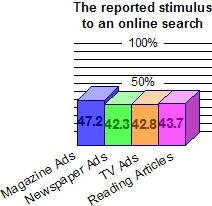There are two drivers behind the meteoric success of sponsored search ads. Yes, the main one is the pre-qualifying nature of an internet search. People signal their interest by the phrases on which they search, which makes this medium great at measurably driving sales. Linking search ads directly back to sales has transformed Google and other paid search providers into the automated equivalent of commission salespeople. (This virtual salesforce is made even better at “closing” through tools like the just-launched Google Website Optimizer.)
The other driver of this medium’s success is the market-driven nature of buying search phrase clicks. Every keyword phrase is priced based on supply and demand, with demand expressed through what competing marketers are willing to pay for the same keyword.Â
Which leads me to yesterday’s announcement from Google, about their purchase of DoubleClick. They have once again expanded their empire, and like any self-respecting colonial power, they will be teaching their new conquest how things are done in the United Googledom.
Banner ads and other online display ads are not nearly as successful at driving sales, although some direct marketers do quite well through sheer numbers and creative chutzpah. No, most online creative units (OCUs) support a sale in far subtler ways, by reinforcing the brand even if a click isn’t generated, and if a click does take place, by attracting consumers to sites and e-newsletters that allow for further product involvement.
The pricing of OCUs on ad networks such as DoubleClick has been fair, in that prices are competitive across the various networks offering the same types of audiences. In this way and others, supply and demand manage media costs.
Somewhat.
The pricing used for ad network media buys is far from perfect. This explains the growth of ad exchanges, where inventory of available impressions across several similar sites and networks is taken into account when calculating what a marketer pays. This comes closer to the bidding model that sponsored search does so well (but not perfectly, because of click fraud).
Not coincidentally, DoubleClick had recently announced it was seriously getting into the ad exchange business. Many theorized this was to help them become an even more desirable target for purchase. Speculation a few weeks ago was that Microsoft would be the prevailing suitor. Instead, Google is paying cash for the company. Lots of it: Twice what they payed for YouTube, at a reported $3.1 billion.
I’ll take the experts’ word for it that this is a brilliant defensive move. It does make sense that depriving Microsoft of this massive portfolio of ad-serving sites is a big win for Google. What I haven’t read much of is speculation on the ways DoubleClick’s business model will change in the wake of this deal.Â
I’ll get the ball rolling with a few to consider:
“AdSensible” ad pricing – This is a no-brainer. Google is essentially the biggest ad exchange in the world. It’s just that until now, most of their inventory was on search results pages, and instead of OCUs they’ve primarily served up text ads. OCUs may never be priced as dynamically as sponsored search ads, but this acquisition takes a step in the right direction.
Better behavioral matching for improved OCU performance — Google and others have been testing products and systems to statistically model browsing behavior. It’s all in the service of predicting — on the fly — receptivity to various ads. This has been going on since the mid-90s, in portals like Go.com, and in ad networks such as Advertising.com — long before they, themselves, were bought by Disney and AOL, respectively. What has impeded everyone’s progress is a relative lack of reach (you need millions of impressions per day) and integration (across various media types). Google has both reach and integration. Especially after yesterday.
Cheaper local advertising — Google is aware that, like politics, all advertising is local. Watch for signs that they will be leveraging DoubleClick in local advertising efforts. They are already making inroads with local businesses who can monetize geo-targeted clicks. For the majority of other local businesses, a truly inventory-driven (read: competitively priced) branding ad system would have a ton of appeal.
I’m writing this on a Saturday, and something tells me that at this very moment Microsoft executives are scribbling on white boards in hastily-called meetings, attempting to overcome what must be a huge strategic loss. In the meantime, bloggers like me have no option but to chalk up another one for the “do-no-evil” empire.
 Put another way, the stimulus improved the PPC ads’ conversion rates. If you were to read the PPC stats in a vacuum, you’d confer more power to the medium than it deserves.
Put another way, the stimulus improved the PPC ads’ conversion rates. If you were to read the PPC stats in a vacuum, you’d confer more power to the medium than it deserves.
